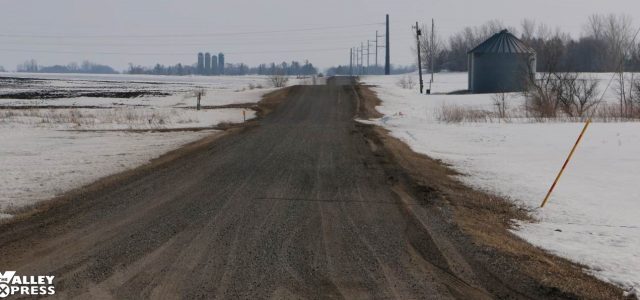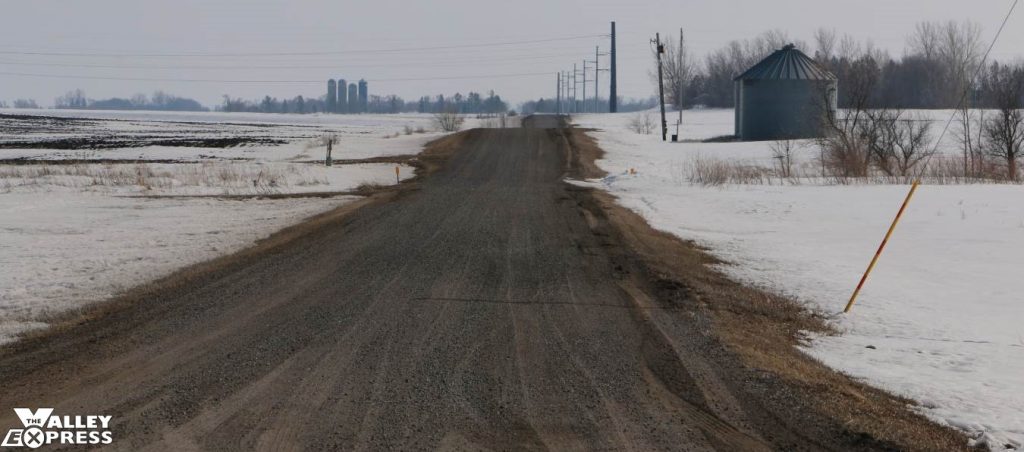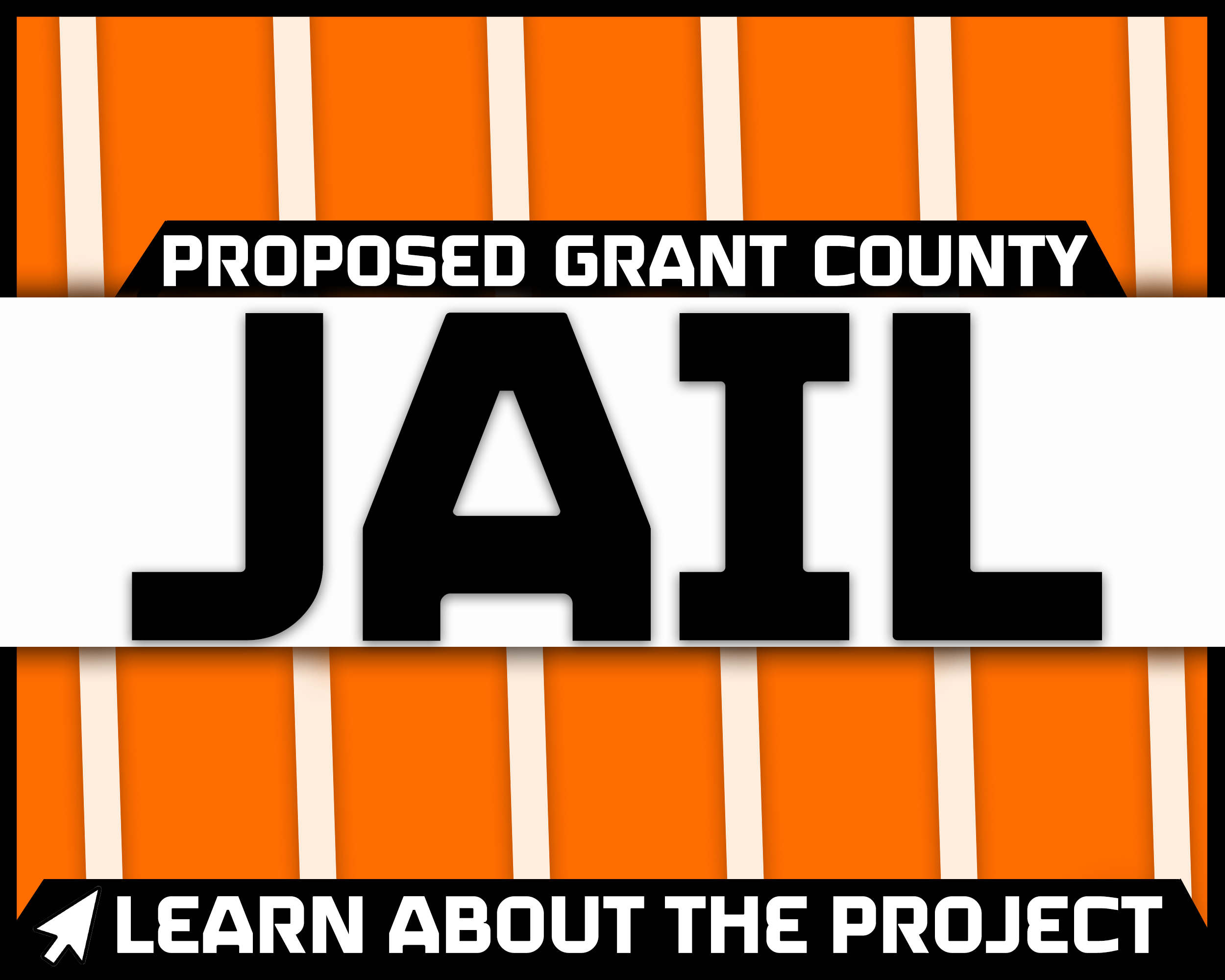

Taking care of Grant County’s roads in the winter is a difficult job. Taking care of Grant County’s roads this winter has been a nearly impossible job according to Mike Mach, who is chairman of the Grant County Commissioners; Bill Tostenson, who is vice chairman; and Daren Peterson, the superintendent of Grant County roads. The group, along with Karen Layher who serves as the commission assistant, and state’s attorney Jackson Schwandt, convened at the courthouse for a special meeting on Monday, March 27.
The discussion focused on answering the questions many people are asking about the current state of Grant County’s roadways. They sought to clarify the solutions being implemented, including during emergency situations and some of the limitations under which the county is forced to operate. They also highlighted what drivers could expect when spring eventually appears as everyone struggles to move about the county during one of the worst winters in recent memory.
Mach said, “The reason I called this meeting is because of all the calls – ‘Why are the roads so bad?’ ‘Can’t we get our roads fixed?’ Well, that’s what we‘re here to talk about. The road conditions right now are terrible at best, especially in the afternoons. This morning they’re frozen so you can kinda dodge the craters.”
Mach continued, “When we’ve got ditches full of snow, the roads aren’t going to dry out anytime soon – not until the snow disappears, the frost goes out, and the roads dry out. We’ve just got to be patient.”
Peterson, who took over the position of superintendent last October, and brought with him nearly 25 years of experience with the county, used this analogy to explain what he sees as the problem: “Everybody whines about the mud on the road. But, have you ever stood in a mud puddle and worked your feet back and forth? It just gets muddier. Every time you drive down that road, it mixes things up the same way.”
“Right now, the top three inches are getting thawed out. The rest of it’s still frozen, so the water has nowhere to go. That’s why it’s staying muddy,” he said. “It’s a physics thing. The more you drive on it, the muddier it gets. Then, people call and want us to blade. Well, if you blade mud, you make more mud.”
Peterson also noted the wind this winter added to the road crews’ challenges, and along with that came equipment breakdowns and the difficulty of finding available parts. “We had one road grader and one truck break down for a week at the same time. We have 10 routes. We have five trucks and five blades. So if you take two units out of your system, you gotta have the other ones pick up that route. That slows things down, too.”
Peterson explained, “Grant County has 457.5 total miles of roads. That’s 280.25 gravel and 177.25 asphalt. But, when you plow snow, each road becomes two miles because you do both sides. So that’s 915 miles of road every time a unit goes out to do snow. That’s only if you hit the system once. A lot of our trucks run two or three times a day up and down their route.”
He also mentioned, “We’ve spent $18,000 on cutting edges this year. That’s probably three times more than in a normal year. Every time a unit goes out, it’s 600-plus gallons of fuel, and lots of my guys have had 50-plus hours of overtime in the last two weeks.” The crew includes 12 employees and a mechanic as needed.
Tostenson said, “I know as a commissioner, I get a hit up about the road conditions and some of the comments include: you just need to spend more money, more overtime, more equipment.
Layher explained that the money for the snow removal and the overtime hours comes out of the general fund. “We budget for both, but in a bad year you don’t budget enough. We build overtime into wages, but we do not have a snow fund. It all comes out of the general fund.”
Mach also asked Layher to address the parameters the county must consider regarding funding to purchase more equipment or hire drivers. “We just don’t arbitrarily say we’re only going to spend $300,000 or whatever the number is,” he said. “We’re limited by the ability to tax.”
Layher outlined the county’s scenario: “The county is limited to CPI and growth dollars each year. We can only increase our taxes (tax column amount) by three percent this following year. An approximate $90,000 increase a year is what we’re limited to. But even if we increase the tax call by $90,000, a road grader will cost us $390,000, so we cannot move forward at a fast enough rate to cover those increased expenses.”
“No matter how many pieces of equipment you run.You’re not gonna change the physics of our freeze-thaw process here in South Dakota,” Peterson added.
“I visited with Kevin Schuelke,” Mach said. (Schuelke, who is head of Grant County Emergency Management, had been unable to attend the meeting as he was attending a meeting in Sioux Falls.) “He says the same thing. And it’s not just Grant County.”
“I came all the way across the state this weekend,” Peterson added. “We’re not alone.”
“I think it’s been a few years since we’ve seen this type of winter,” Layher reflected, “and like Darren said, the wind has been a battle this year. In past years, blizzards would blow snow, and we’d clean it up and push it out into fields because there was time between blizzards. This year, there hasn’t been any time between storms!”
Peterson noted, “ We get the people that complain there’s three inches of snow left after the blade goes by. But then if you take it clear down to the gravel, all the gravel is in the ditch in the spring. The roads are muddier yet.”
“And I don’t care who the operator is or how many years of experience they have, every time you blade snow off a gravel road, you take some gravel,” Mach said. “Because when you drive through the snow, it throws it up and mixes into the snow. You take the snow off, the gravel goes in the ditch.”
“So, the happy medium for that is to leave an inch or two or three?” Tostenson asked.
“To leave a little bit of snow on the gravel is the best way to keep the gravel there in the spring,” Peterson explained. “Otherwise, it’s gonna be worse than what you see now. And like I said, it’s gonna be muddy no matter what. Even the township roads. Everything is that way because the ground isn’t completely thawed and the water has nowhere to go. Stomping in a mud puddle, you make a bigger mud puddle.”
“And it’s human nature to be impatient. It’s human nature to think I need to be first,” Tostenson theorized.
“Yes.” Layher said, “We’re just asking the public for patience.”
“But it’s not just for today,” Tostenson noted, “It’s another three or four months going into the spring when we get to thaw, and then we get folks with agricultural equipment on the roads.”
“Are there procedures in place if there’s an emergency, such as a heart attack or something?” Tostenson inquired. “A way to get out to a place even though no roads are open or it’s blizzard conditions?”
“I did speak with our emergency people – the fire chief and the two assistant chiefs,” Mach said. “We have guys that will jump in a plow and go out in front of us,” Mach replied. “We’ve also got the Snowmobile Club. Folks are coordinated for volunteering. The Snowmobile Club is very good about helping. They’ll jump on a sled anytime for us.”
“A snowmobile will go down each side of the highway, so the plow can follow them,” Peterson
explained. “The ambulance, or whoever needs to get there, can follow the plow truck.”
Moving on, Mach said, “What I think what we got going for us right now is the weather. It thaws a little during the day and freezes at night. I think that’s helping quite a bit.”
“Then, I think we also need to address when the snow does melt, and we have roads barricaded or closed,” Layher said. “Everyone needs to follow the rules and not go around.“
People have lost their lives doing that,” Tostenson agreed.
“We put those, “Road Closed” signs up for a reason. Either a bridge, culvert, or road has collapsed, and we do not want anyone going around barricades this spring,” Layher emphasized.
“I think what we’re going to see is culverts plugged with ice chunks that break loose,” Mach said. “There will be bridges and roads submerged. It’s going to be treacherous!”
If we have a fast thaw, Layher added. “And then a rain storm too,” Mach continued.
Peterson recalled the year the road crews put up barricades at a bridge. “Drivers threw ’em off to the side and kept driving. Well, underneath the asphalt was a 10-foot-deep hole. We ended up taking equipment out there and parking it across the road to get people to stop. They just would not stop throwing the barricades in the ditch.”
“So people need to think ahead, be patient, and obey the law,” Tostenson recapped. “Another thing I’ve noticed is that people call Grant County – Karen or Darren, or the commissioners – with concerns or complaints about township roads. Township roads are not a county responsibility. They belong to two different government entities. Townships take care of township roads.”
“One more thing that’s important is about the guys out there moving snow,” Tostenson said. “Everyone needs to be patient with them and respect the size of that equipment. I wish people wouldn’t stop them, or honk their horns, or distract them from their job.” He added, “Those vehicles are dangerous – both to the public and the operators. We’ve all been on the road when you can’t see a thing behind them. You can’t see a thing in front of them either.”
“I think you’re all just asking the public to be aware of the situation and to know that the County is doing their best,” Layher summarized. “We get it. We struggle with driving on these roads, too!”













No comments so far.
Be first to leave comment below.